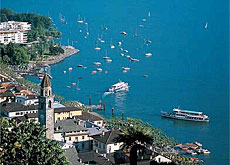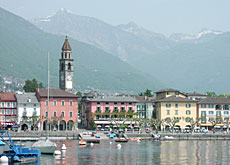Searching for truth on Monte Verità

Ascona is Switzerland’s most popular southern resort, but the cradle of European counterculture is only a shadow of its former self.
Swiss-Germans and Germans come for a relaxing holiday on the lakeside, most unaware that leading European anarchists once tried to build a utopian society here.
“Today, tourists come by the busload, and they’re badly dressed,” laments 82-year-old Ascona resident, Ursula Roelli. “It’s not like it once was.”
Roelli is the daughter of the Swiss-German architect who built the Bauhaus hotel on Monte Verità (mountain of truth) in 1927, the name of the hill overlooking Ascona.
Monte Verità was also the name of the alternative society founded there more than 100 years ago when a handful of European intellectuals decided to start a movement based on a primitive form of socialism and vegetarianism.
Anarchists
News of the society quickly spread, and soon anarchists from across the continent were descending on the poor fishing village.
They came to experiment, and were frowned upon by the villagers because of their beliefs and the fact that they carried out many of their experiments in the nude.
“The women of Ascona always had to wear black,” remembers Roelli. “The local people were very religious so of course they didn’t like what was going on there.”
By the 1930s Monte Verità had gone through various transformations, moving away from its strictly utopian principles.
It became a centre for experimental dance and attracted many artists and writers: Hermann Hesse, Paul Klee and Aleksey von Jawlensky, to name but a few.
Counterculture
Everyone from Mahatma Gandhi and George Orwell to Germany’s National Socialists “fed on a living stream of thought that had its source in Ascona”, wrote American professor Martin Green in his book, “Mountain of Truth. The Counterculture begins.”
But the truth of the matter is that counterculture moved on to other places, and by the 1950s Ascona was on its way to becoming what it is today: a chic holiday resort and place in the sun where northern Europeans go to retire.
“It would be good to invite artists here again; writers and painters with new ideas who could breath life back into the place,” says Claudio Rosetti, director of the international conference centre that has taken over the Monte Verità site.
Spirit
“However, one still does sense the spirit of Monte Verità,” Rosetti continues as he opens the door to the museum devoted to the alternative movement.
The Casa Anatta building, which houses the museum, was one of the first constructed by the utopians.
“It’s unfortunate that the conference centre, run by Zurich’s Institute of Technology, is closed to all but scholars. That’s why I would like to open it up more for cultural events.”
Michele Vester, who lives close to the renovated Bauhaus hotel, believes Monte Verità has remained a special place.
“You can still feel the energy that drew so many interesting people from all over the world,” says the interior decorator.
“Artists who came here – and still come here – have done some of their most inspired work on Monte Verità,” he adds.
Self-sufficient
Vester’s grandfather, Karl, came to Ascona in 1900 and became one of the movement’s first members, eventually building his own house on the hill overlooking a lush subtropical garden and Lake Maggiore.
Vester, who now lives in the house, says it was his grandfather’s wish to create his own utopia, where he tried to live as self-sufficiently as possible, baking his own bread and keeping a small herd of goats.
“He made special bread but he smelled terribly of goats,” laughs Ursula Roelli. “He was the last of that first group to remain on Monte Verità.”
Besides Roelli’s memories, there are pictures in the Casa Anatta of the longhaired Vester, and many of his companions, dancing and gardening in the nude.
swissinfo, Dale Bechtel in Ascona
Ascona is a lakeside resort near Locarno in the southern canton of Ticino.
It was a poor fishing village when European intellectuals discovered it, founding a utopian movement in 1900 called the “Vegetarian cooperative”.
The founders were the pianist and feminist leader, Ida Hofmann, Henri Oedenkoven, the son of an industrialist, and the brothers Karl and Arthur Graser.
The society soon attracted anarchists from across Europe, and leading artists were to follow them later.
Some of the original Monte Verità buildings have been turned into museums devoted to the movement, and the Bauhaus hotel has been converted into a conference centre.

In compliance with the JTI standards
More: SWI swissinfo.ch certified by the Journalism Trust Initiative


You can find an overview of ongoing debates with our journalists here. Please join us!
If you want to start a conversation about a topic raised in this article or want to report factual errors, email us at english@swissinfo.ch.